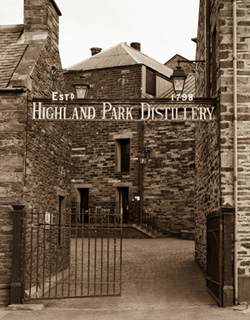Scots and Whisky as a Source of Income
Scotland
The Scots were the first to turn whisky into a source of income, and until the 16th century, its production grew exponentially. The problem arose when the excesses of production and consumption began to have negative effects. In fact, grains were excessively diverted to whisky production rather than food supplies, and its overindulgence led to significant social degradation. The solution came in the form of a series of restrictions and taxes imposed on distilled spirits, leading to production control and further taxes imposed by the English Parliament in 1713 and 1725.
A Clandestine Activity
 The exorbitant taxes imposed by the English made the Highlands (a vast and wild territory difficult for His Majesty's inspectors to control) a perfect place for clandestine activities such as whisky smuggling. By the late 19th century, it is estimated that there were as many as 400 illegal distilleries in and around Edinburgh compared to only 8 authorized ones. Many of today's distilleries started as illegal ones, such as Ardbeg, Highland Park, and Glenlivet, to name a few. It was only in 1823, with the Excise Act, that taxes on whisky were reduced to an acceptable level, putting an end to illegal distillation.
The exorbitant taxes imposed by the English made the Highlands (a vast and wild territory difficult for His Majesty's inspectors to control) a perfect place for clandestine activities such as whisky smuggling. By the late 19th century, it is estimated that there were as many as 400 illegal distilleries in and around Edinburgh compared to only 8 authorized ones. Many of today's distilleries started as illegal ones, such as Ardbeg, Highland Park, and Glenlivet, to name a few. It was only in 1823, with the Excise Act, that taxes on whisky were reduced to an acceptable level, putting an end to illegal distillation.
The Dawn of the Industrial Revolution
With taxes now at a tolerable level and distilleries emerging from clandestinity, entrepreneurs began to modernize distilleries, improving production and increasing quality, leading to a significant recovery. Driven by brilliant entrepreneurs such as James Chivas, Arthur Bell, George Ballantine, and many others, Scotland set out to conquer the global market. By 1900, almost all distilleries were producing blended whiskies, combining single malt Scotch with grain whisky to create blends with low production costs, making them more competitive in the market.
The 20th Century, the Great Wars, and American Prohibition
At the beginning of the 20th century, the Scottish whisky industry was at its historical peak, with distilleries thriving. However, the onset of the century also saw the arrival of a recession in Great Britain, and the subsequent Great War imposed very repressive fiscal measures that led to the closure of many distilleries. This was further compounded by American Prohibition, which put the Scottish whisky industry to the test. The end of Prohibition brought prosperity back to the industry, but only until World War II (in some cases, during the war, certain distilleries, due to their location and structure, were closed and repurposed for the British army). In the post-war period, Scottish distilleries began to prosper again, increasing exports, but this renewed momentum lasted only until the next crisis between the 1960s and 1970s. It is only in the last twenty years that we have witnessed a stable recovery, as evidenced by the appreciation Scottish whiskies are receiving worldwide.
